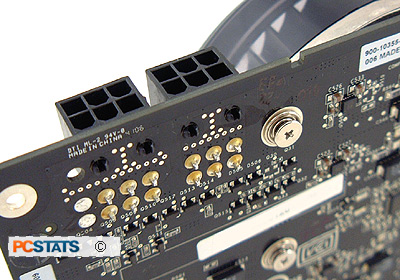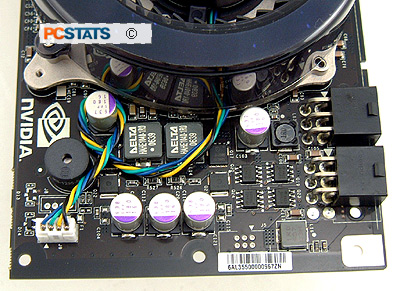 While Intel and AMD have moved aggressively towards reducing the amount of power their processors consume, nVIDIA and ATi have largely neglected this issue. In fact under load it's possible for videocard GPUs to suck up more power than the CPU draws. With the nVidia G80 core built on TSMC's 90nm technology, you know the graphics card will use up a lot of power.
While Intel and AMD have moved aggressively towards reducing the amount of power their processors consume, nVIDIA and ATi have largely neglected this issue. In fact under load it's possible for videocard GPUs to suck up more power than the CPU draws. With the nVidia G80 core built on TSMC's 90nm technology, you know the graphics card will use up a lot of power.
To get an
idea at how much power the NX8800GTX-T2D768E-HD may consume, the PCI Express x16
slot provides up to 75W, and each additional six pin VGA power connector can
provide an additional 75W of power. That means the MSI NX8800GTX-T2D768E-HD has
the potential to draw 225W of power!
While we have no way of measuring directly how much power the
NX8800GTX-T2D768E-HD uses, we will measure total system power draw and
compare the same basic installation with a couple different videocards to
get a rough idea of how power consumption fluctuates for each specific
videocard.
The test system will consist of an AMD Athlon64 FX-62, Asus M2-CROSSHAIR motherboard, a reference Athlon64 FX-62 cooler,
2GB of Corsair Twin2X2048-6400C3 memory, a 74GB
WD Raptor hard drive, an 8x Gigabyte DVD writer and a floppy drive. The pPower supply used
here is the APFC compliant Seasonic S12-600W.
The videocards that will be tested against the MSI
NX8800GTX-T2D768E-HD will come from both the nVIDIA and ATi camps. Representing
nVIDIA will be MSI NX7950GX2-T2D1GE (GeForce 7950GX2), a MSI NX7900GTX-T2D512E
(GeForce 7900GTX) and a Gigabyte GV-NX76T256D-RH
(GeForce 7600GT) videocard. Representing ATi will an Asus X1900XTX 2DHTV/512M/A (Radeon X1900 XTX) and an Asus EAX1950PRO/HTDP/256M/A (Radeon X1950 Pro) videocard.
videocard Power Consumption on Total System
Power Draw Tests Power Consumption on Total System
Power Draw Tests |
| Idle: |
Watts* |
Ranking |
|---|
| MSI NX7950GX2-T2D1GE |
183 |
   |
| MSI NX7900GTX-T2D512E |
165 |
   |
| Gigabyte GV-NX76T256D-RH |
140 |
   |
| Asus EAX1900XTX 2DHTV/512M/A |
160 |
   |
| Asus EAX1950PRO/HTDP/256M/A |
150 |
   |
 MSI NX8800GTX-T2D768E-HD MSI NX8800GTX-T2D768E-HD |
196 |
   |
 MSI NX8800GTX-T2D768E-HD (Overclocked to 665/1066) MSI NX8800GTX-T2D768E-HD (Overclocked to 665/1066) |
200 |
   |
| Load: |
Watts* |
Ranking |
|---|
| MSI NX7950GX2-T2D1GE |
315 |
   |
| MSI NX7900GTX-T2D512E |
277 |
   |
| Gigabyte GV-NX76T256D-RH |
213 |
   |
| Asus EAX1900XTX
2DHTV/512M/A |
333 |
   |
| Asus
EAX1950PRO/HTDP/256M/A |
252 |
   |
 MSI NX8800GTX-T2D768E-HD MSI NX8800GTX-T2D768E-HD |
345 |
   |
 MSI NX8800GTX-T2D768E-HD (Overclocked to 665/1066) MSI NX8800GTX-T2D768E-HD (Overclocked to 665/1066) |
360 |
   |
[ *This figure represents total system power
consumption in Watts, either with the system at idle, or the peak
value recorded while running 3DMark06.
]
 It should come as no surprise that that the MSI NX8800GTX-T2D768E-HD draws
the most power at idle, although the dual GPU MSI NX7950GX2-T2D1GE doesn't trail
by too much. The Asus EAX1900XTX 2DHTV/512M/A is rather energy efficient at
idle, but it is the Geforce 7600GT card which earns the lowest power consumption
prize at idle.
It should come as no surprise that that the MSI NX8800GTX-T2D768E-HD draws
the most power at idle, although the dual GPU MSI NX7950GX2-T2D1GE doesn't trail
by too much. The Asus EAX1900XTX 2DHTV/512M/A is rather energy efficient at
idle, but it is the Geforce 7600GT card which earns the lowest power consumption
prize at idle.
Under load, the power values definitely increase by
dramatic amounts. The MSI NX8800GTX-T2D768E-HD based system consumes a peak of
345watts, and when overclocked that value increases by 15W. We're surprised at
how much power the ATi EAX1900XTX 2DHTV/512M/A uses while under load (333Watts),
it's higher than the dual GPU MSI NX7950GX2-T2D1GE videocard based
system (315Watts)!
One thing is clear, neither ATi or nVIDIA is a
saint when it comes to power usage of their modern graphics cards.
Videocards definitely gobble up a lot of power a total computer
system uses!
nVIDIA is usually the pioneer of new videocard
technologies so we look forward in seeing how it will work to addresses
the power issues that affect modern videocards. Videocards have started to move towards parallel
computing like processors, is that the way of the future?
In any case it will certainly be interesting to see what nVIDIA and ATi
end up doing, because power consumption cannot continue unabated.... no, we want to start seeing
flagship videocard power consumption drop.
